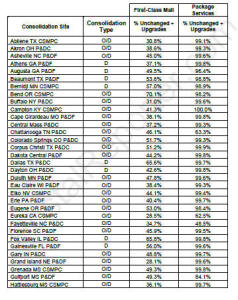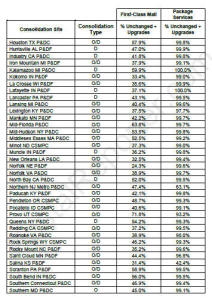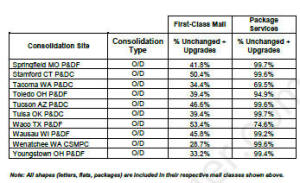 1.2.15 PostalReporter.com reported several days ago that as it stands now most of the plants are scheduled for closure/consolidation starting in April and not January 2015. In fact there are no plants scheduled for closure in January 2015. The first graphic show plants on the list that were already in the process of closure. Also, USPS started the closure/consolidation process on more than half of 82 plants months ago. (see graphic for partial list of the plants)
1.2.15 PostalReporter.com reported several days ago that as it stands now most of the plants are scheduled for closure/consolidation starting in April and not January 2015. In fact there are no plants scheduled for closure in January 2015. The first graphic show plants on the list that were already in the process of closure. Also, USPS started the closure/consolidation process on more than half of 82 plants months ago. (see graphic for partial list of the plants)
USPS has now confirmed what PostalReporter.com reported several days ago.
Here is how USPS explains the Network Rationalization Service Standard Impacts:
The postal facility consolidation proposals developed in accordance with the USPS Handbook PO-408 Area Mail Processing (AMP) guidelines that are part of the Network Rationalization Plan were submitted for public comment and acted upon by postal management in early 2012. Consistent with Pub.L. 109-435, Title III, § 302(c)(3)(D)(ii), each AMP proposal contained a summary of available information regarding the service standard changes expected to be implemented and a summary of other known service effects expected to result from the Network Rationalization initiative, including the specific service standard changes that were being contemplated for various postal products.
Ordinarily, when a specific AMP facility consolidation proposal is being contemplated, existing service standards and the configuration of the remainder of the network are held constant. In those circumstances, each specific proposal submitted for public comment and reviewed by senior postal management can include an estimate of the percentage of First-Class Mail and Package Services volume in the affected service area that is expected to experience no service change, a service upgrade or a service downgrade. Although the service standard change proposals under review in early 2012 were known, they had not been finally determined. The simultaneous pendency of approximately 250 AMP facility consolidations meant that the network could not be held constant for purposes of estimating for each specific AMP consolidation the percentage of mail volume expected to experience a specific service standard change. Accordingly, such information — neither specifically required by section 302(c)(3)(D)(ii) nor necessary to a determination of the feasibility of a specific AMP consolidation — was not included in the Network Rationalization consolidation proposals submitted for public comment and acted upon in early 2012. Nevertheless, each AMP facility consolidation decision package approved under these conditions in early 2012 contained an advisory notice that after the service standard changes were finalized and the future network configuration was resolved, estimates of the percentage of mail volume expected to experience specific service standard changes could be calculated and would be posted. This document contains those estimates.
The relevant service standard business rule changes were implemented in two phases. The first phase was initiated on July 1, 2012. The second phase of the business rule changes occurs on January 5, 2015.
Consistent with USPS Handbook PO-408, the following analysis utilizes volume data from the Origin Destination Information System (ODIS) for the time period when the facility consolidation studies were completed. The starting point is the service standards from January 1, 2012 compared to those in effect October 1, 2015. This reflects the impact of the national service standard changes effective July 1, 2012 and January 5, 2015, as well as the impacts of the consolidations. This analysis assumes implementation of all of the listed consolidations.
The percentages shown for each facility consolidation represent the estimated volume of mail for which the service standard either is unchanged or upgraded.
Facilities: Customer Service Mail Processing Center (CSMPC), Processing & Distribution Center (P&DC) and Processing & Distribution Facility (P&DF).
Consolidations: Originating & Destinating (O/D), Originating only (O), Destinating only (D).
Phase 1
The facility consolidations listed are those completed before October 1, 2014. These consolidations are generally referred to Phase 1 consolidations in the Network Rationalization plan because they could be implemented before the January 5, 2015 (Phase 2) service standard business rule changes. see list NR-Service-Standard-Impacts-2015 (PDF)
Phase 2
The facility consolidations listed are the Phase 2 consolidations in the Network Rationalization associated with the second phase of the service standard business rule changes and planned for final implementation after January 5, 2015.
Note: Originating Mail date: This date represents the first date that all originating letter, flat and package mail will be processed in the activating plant
Destinating mail: This date represents the first date that destinating letter, flat and package mail will be processed in the activating plant.
USPS has already implemented the Network Consolidations 2015 ‘Originating Mail’ in the following facilities: Huntsville AL P&DF, Industry CA P&DC, Kalamazoo MI P&DC, Lafayette IN P&DF, Lancaster PA P&DF, Muncie IN P&DF, Queens NY P&DC, Athens GA P&DF, Augusta GA P&DF, Beaumont TX P&DF, Bemidji MN CSMPC, Dallas TX P&DC,Dayton OH P&DC, Fox Valley IL P&DC, Gainesville FL P&DF.
The remaining dates represent when the ‘Destinating Mail’ and ‘Delivery Point Processing (DPS) Mail’ will be processed in the activating plant.
(click on graphic for larger view)



Management continues to embrace the idea that they have the God-given Right to Mismanage
It won’t bother me, I still have overtime every day.
With 82 plants being shut down how will packages make it on time? [priority mail]
With 82 plants closing how can the packages make it on time?
So if we close 82 plants how can the package mail make it on time?
Stupid is what stupid does. I am referring to mgmt. Bad mgmt. is the cause for co. failure. Hope the managers of these 82 plants get it stuck to them.
Network Irrationalization Part II. No stopping USPS mismanagement.
I have been a letter carrier for 30 plus years and have seen many many things with miss management throughout. THE CART BEFORE THE HORSE way of operations on almost every decision has cast an ugly shadow over leadership into the future with every manager at any level below the brainless trust being forced to proceed and of course us having to make excuses to our customers each time this happens. The true reason you as a customer have been satisfied with your service is the devout men and women in blue, the clerks and mailhandlers and truck drivers and middle management who digest the near impossible tasks given us and use what works for us and anyone else in any business-COMMON SENSE. We will as the workforce continue to provide the very best service we can to every single household because we care- I care for everyone of my people and so does many many of our devout people.
More lies by management to destroy the service that all Americans are guaranteed by the constitution
What about the OIG’s report that it hasn’t been done correctly. Interesting the liars at the postal service made no mention of that
i agree in fact, the same ones whining now are the ones that whined about thier jobs in the early 90s when the OCR’s took over the LSM’s no one lost thier job then nor will they now. so say ye now nay sayers?
Git er done ~~~ the sooner the better. Once done there will be stability and the whining can stop. Be eternally thankful the PO is not like private industry where they simply terminate everyone and only rehire the hard workers ~~~~ of which very few of the whiners would qualify.
Yeah .. You must be management :p
If anyone can explain any of this I will award you with the ” for the love of all things holy speak ENGLISH!” award for 2015
Translation: Here’s the latest round of blatant lies by postal mgmt.
Am I seeing this right? They plan on 1st class being changed dramatically but package service to be nearly 100% unchanged. Example MS 1st class 36% but package service still 99.7%. The planners can’t even being buying these numbers
That’s absolutely right Parcels are where they are making their major profits they rather go all in for that.